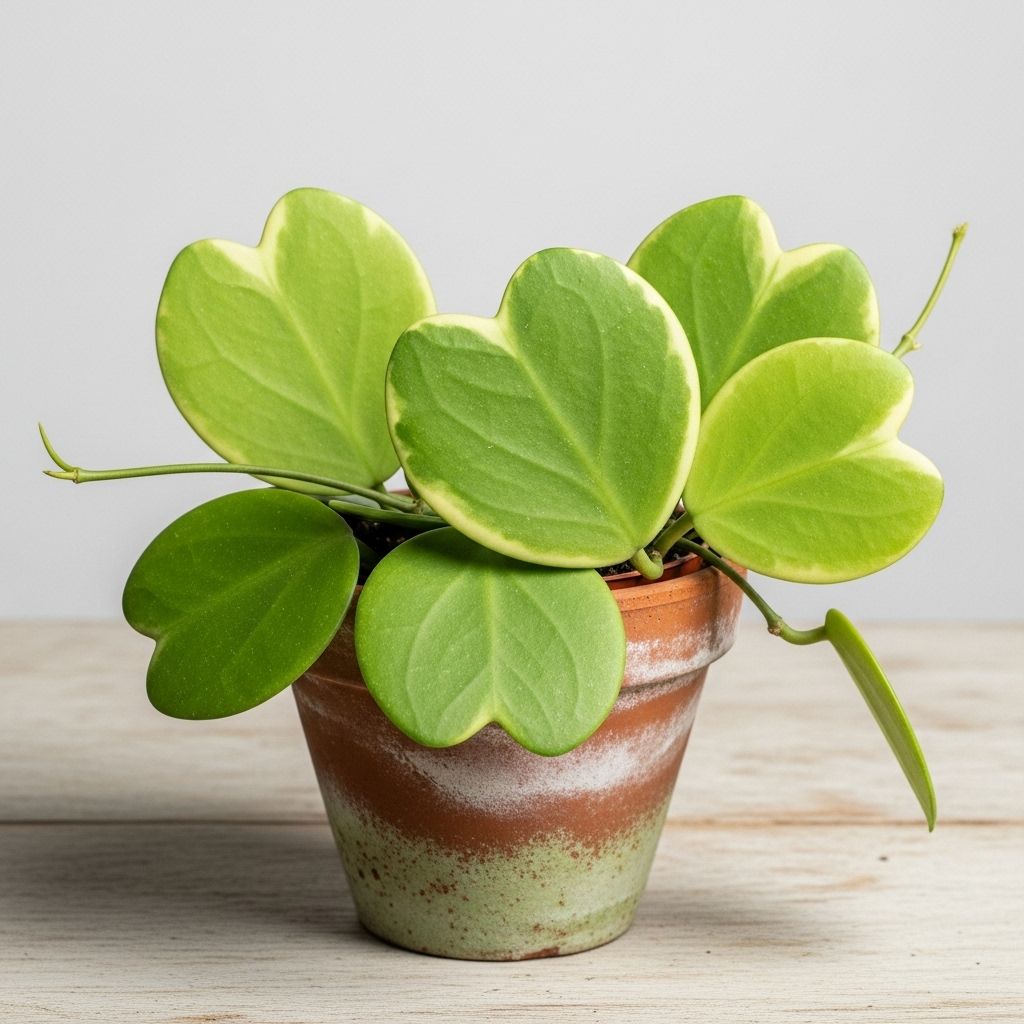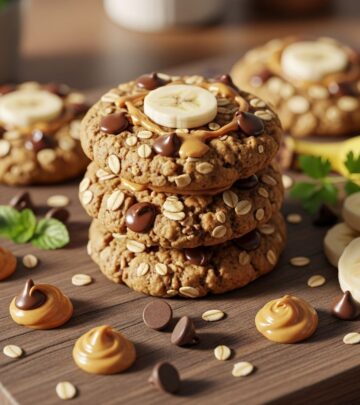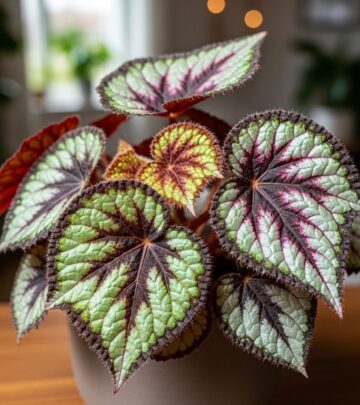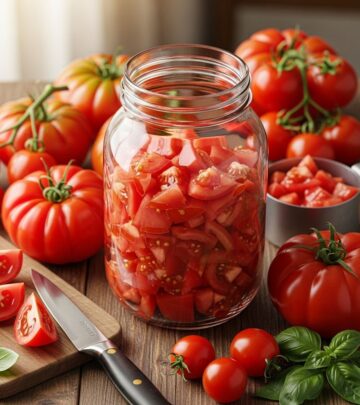Gardening 101: The Hoya Heart (Hoya kerrii) Houseplant Guide
Right light and watering encourage lush leaves and star-shaped blooms indoors.

Image: HearthJunction Design Team
The Hoya Heart, often called the Sweetheart Hoya or Valentine Hoya, is an endearing succulent houseplant beloved for its thick, heart-shaped leaves. Native to Southeast Asia, especially Thailand and Indonesia, Hoya kerrii is prized not just for its iconic foliage but also for its adaptability as a houseplant—making it perfect for both beginners and experienced indoor gardeners.
Table of Contents
- About Hoya Heart
- Growing Conditions: Light, Watering, & Humidity
- How to Plant a Hoya Heart
- Pruning, Propagation, and Growth Habits
- Fertilizing Hoya Heart
- Repotting and Soil
- How to Encourage Flowers
- Pet Safety & Toxicity
- Common Problems & Troubleshooting
- Frequently Asked Questions
About Hoya Heart
The Hoya Heart (Hoya kerrii) is a succulent vine known for its uniquely shaped leaves that resemble a perfect green heart. While it is most often sold as a single, rooted leaf (making it a popular Valentine’s gift), with the right conditions and a rooted stem node, it can develop into a climbing or trailing plant, producing long vines and clusters of fragrant, star-shaped flowers as it matures.
- Family: Apocynaceae (dogbane family)
- Origin: Southeast Asia (Thailand, Laos, Cambodia, Indonesia)
- Growth Habit: Succulent perennial vine
- Foliage: Glossy, fleshy, heart-shaped leaves
- Flower Color: Clusters of white-to-pink, waxy, star-shaped blooms when mature
- Nickname: Sweetheart plant, Valentine Hoya, Lucky-heart
Growing Conditions: Light, Watering, & Humidity
Light Requirements
- Bright, indirect light is ideal. Prolonged direct sun can scorch the leaves. (East- or west-facing window is best.)
- Tolerates lower light scenarios, but growth may slow and blooms may not appear.
Watering
- Water only when the soil is completely dry. For most homes, this means approximately every 7–10 days—but always check the soil with your finger first.
- Do not let the plant sit in water. Drain excess after watering to prevent root rot.
- During winter, reduce watering frequency; the plant enters dormancy and needs less moisture.
Humidity
- Normal household humidity (around 40%) is sufficient.
- Likes a boost in humidity via pebble trays or misting, especially in dry environments.
Temperature
- Thrives between 60–85°F (16–29°C).
- Never expose to temperatures below 50°F (10°C).
- Keep away from cold drafts and sudden temperature drops.
How to Plant a Hoya Heart
Hoya Hearts usually arrive as either a single-leaf cutting or as part of a rooted, multi-leaf stem. Planting and care basics are simple, but there are differences to note:
- Single-leaf Hoya: These often remain as solitary leaves and typically will not grow into a vine unless a stem node is attached.
- Trailing Hoya: Given the right conditions and a true stem, the plant will eventually send out vines and additional leaves.
Planting Tips:
- Use a well-draining, cactus or succulent soil mix with additional perlite/grit for aeration.
- Select a container with ample drainage holes to ensure roots never sit in excess water.
- Hoyas prefer a slightly root-bound pot; re-pot only when roots escape the drainage holes or growth stalls.
- After purchase, wait at least 6–12 months before the first repotting—this reduces transplant shock.
Pruning, Propagation, and Growth Habits
Pruning
- Pruning is rarely needed. Only remove dead or damaged stems and leaves as necessary.
Propagation
- Leaf cuttings: Propagate by removing a healthy leaf with at least a small portion of stem and a growth node attached. Without a node, the rooted leaf will likely not produce a vine.
- Allow cuttings to callus, plant in moist, well-draining soil, and keep in medium light. Root growth typically occurs in several weeks.
Growth Habits
- Hoya kerrii is a slow grower, especially as a single-leaf specimen. Vining forms will eventually trail or climb given support.
- They are long-lived plants and can survive decades with proper care.
Fertilizing Hoya Heart
- Apply a general-purpose liquid fertilizer diluted to half-strength every 4–6 weeks during the active growing season (spring and summer).
- Do not fertilize during winter dormancy.
- Never apply fertilizer to dry soil—water first to avoid burning the roots.
- Succulent-specific fertilizers can also be used sparingly during growth periods.
Repotting and Soil
- Hoya Heart enjoys being root-bound; only repot every 3–4 years or when roots are growing through the drainage holes.
- Use a pot only slightly larger than the current one to encourage flowering and prevent overwatering.
- Refresh the potting mix during repotting to prevent soil compaction.
- Delay repotting for at least 6–12 months after purchase to minimize stress.
How to Encourage Flowers
- Mature plants (usually older than 2–3 years) may produce clusters of fragrant, star-shaped blooms if cared for properly.
- Key to flowers: allow the plant to become root-bound, increase humidity, provide bright indirect light in spring, and fertilize monthly.
- Patience is essential: a single-leaf plant will almost never flower, while vining, node-rooted specimens need several years to mature.
Pet Safety & Toxicity
- Non-toxic to humans and pets according to general houseplant toxicity listings.
Common Problems & Troubleshooting
| Problem | Symptom | Solution |
|---|---|---|
| Root rot | Yellowing, mushy leaves; soft roots | Remove affected parts, repot in fresh, dry soil, adjust watering habits |
| Leaf scorch | Brown, crispy edges, faded color | Move out of direct sun, ensure filtered or indirect light |
| Stunted growth | Slow or no new leaves/vines | Check light levels, avoid over-potting, use diluted fertilizer in season |
| Wilting/lethargy | Droopy, floppy leaves in winter | Normal during winter dormancy—reduce water and wait for spring |
| Pests | Tiny insects, sticky webbing | Treat with insecticidal soap or neem oil, quarantine affected plant |
Frequently Asked Questions (FAQs)
Q: My Hoya Heart is a single leaf. Will it ever become a vine?
A: A single-leaf Hoya Heart without a node will likely remain as a decorative leaf and not develop into a vining plant. For vines, ensure your specimen includes a stem node.
Q: How often should I water my Hoya Heart?
A: Water only when the soil has completely dried out—typically every 7–14 days, less frequently during winter dormancy.
Q: Do I need to mist my Hoya Heart?
A: While not mandatory, a humidity boost from misting or a pebble tray can benefit the plant, especially during dry seasons or if your home has low humidity.
Q: Does the Hoya Heart bloom indoors?
A: Vining, mature plants may flower indoors given optimal light, humidity, and age (generally 2–3 years or more).
Q: Is Hoya kerrii safe for pets?
A: Hoya hearts are considered non-toxic to both pets and humans, making them ideal for households with animals or children.
Key Hoya Heart Care Tips
- Let soil dry completely before watering
- Provide bright, indirect light for the best growth
- Avoid direct, harsh sunlight
- Repot only when necessary, as Hoya kerrii likes to be root-bound
- Boost humidity but do not overwater
- Feed with a diluted, balanced fertilizer during spring and summer only
- Don’t expect trailing vines or flowers from a single-leaf Hoya Heart
- Be patient—growth is slow but steady with good care
Conclusion
With its charming foliage, resilience, and minimal care needs, the Hoya Heart is an ideal choice for anyone seeking a long-lasting, attractive, and pet-friendly houseplant. Whether you’re gifting a rooted leaf as a gesture of love or growing a mature vining specimen, following these care principles will ensure your Hoya kerrii thrives for years to come.
References
Read full bio of Anjali Sayee












